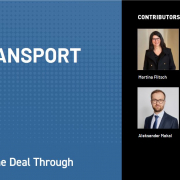Re- routing Obligations of Airlines of Airlines in Austria
According to Article 5 (3) of Regulation 261/2004, operating air carriers are not required to make compensation payments to passengers if the cancellation (or substantial delay) was caused by extraordinary circumstances which could not have been avoided even if all reasonable measures had been taken. However, the interpretation of this provision has led to a range of court decisions regarding the criteria of extraordinary circumstances and reasonable measures. This article will focus specifically on the reasonable measure of re-routing a passenger to their final destination, as interpreted by the European Court of Justice (ECJ) and Austrian courts, particularly the Regional Court Korneuburg.
It must be kept in mind that to successfully defend against a claim for compensation payment, the operating air carrier must prove the existence of extraordinary circumstances and that all reasonable measures were taken to prevent the cancellation or substantial delay. Re-routing a passenger is considered one of these measures. Therefore, the air carrier’s re-routing of a passenger is a crucial factor in determining whether a claim for compensation should be rejected.
As a general rule, the air carrier must re-route the passenger in a way that allows them to reach their final destination as soon as possible.
In practice, it is often difficult to prove that the re-routing the air carrier chose was indeed the fastest option and we are regularly confronted with passengers (often represented by claim collecting companies) presenting a list of alternative flights that would have allowed them to reach their final destination sooner than with the flight chosen by the air carrier. In such cases, the air carrier must prove why the passengers have not been rebooked to these flights instead (e.g., because these flights were already fully booked).
The air carrier must consider all available flights and not just those operated by itself, a member of the same alliance or an air carrier, with which it has entered into a contractual relationship.[1] Further, it is obliged to even offer a flight if it assumes that the passenger will not accept it because of inconveniences linked thereto (such as an overnight stay at another airport)[2] and even if the passenger already booked an alternative flight themselves.[3]
The relevant timing of the air carrier´s assessment, to which flight the passenger should be rebooked, is when it is predictable that the passenger cannot be transported on the original flight, e.g., because this flight will be cancelled, or a delay of the first flight leg leads to the passenger missing his/her second flight leg.[4] To allow the court to assess this, the temporal components must be included in the air carrier´s defence.[5]
The air carrier must offer re-routing in “immediate temporal connection” with the announcement of the cancellation.[6] However, the air carrier is not obliged to re-route a passenger to a flight if such re-routing constituted an “intolerable sacrifice” for that air carrier in the light of the capacities of its undertaking at the relevant time.[7] The Regional Court for Commercial Matters Vienna (Handelsgericht Wien) once decided that for a low-cost carrier, re‑routing a passenger to a different carrier that typically charges ticket fares three times higher than the low-cost carrier´s ticket fares would constitute such an intolerable sacrifice.[8] It is unclear whether other courts, in particular the Regional Court Korneuburg, will have the same understanding.
If the air carrier fails to re-route the passenger in a way that allows them to reach their final destination as soon as possible, it may not only be obliged to pay a compensation payment (even if there have been extraordinary circumstances), but also to bear the costs of the passenger´s self-organised rebooking.[9]
The overview of criteria in connection with an air carrier´s obligation to re-route passengers given in this article aims to inform about relevant aspects to consider when assessing such cases. However, it also highlights the variety of (national) court rulings that must be examined when dealing with passenger claims. Therefore, it is essential to work with specialists and closely assess cases to have clarity about the chances of succeeding in court proceedings before investing substantial resources in them.
Don´t hesitate to contact our Aviation Team to learn more about passenger claims in Austria.
This article was also published on Lexology and can be accessed by clicking here.
[1] ECJ, C-74/19; Regional Court Korneuburg, 21.09.2021, 22 R 263/21p; RKO0000032.
[2] Regional Court Korneuburg, 22.09.2022, 22 R 176/22w; RKO0000043.
[3] Regional Court Korneuburg, 21.06.2022, 22 R 18/22k; RKO0000041.
[4] Regional Court Korneuburg, 23.07.2020, 22 R 124/20w; RKO0000015.
[5] Regional Court Korneuburg, 03.09.2020, 22 R 152/20p; RKO0000013.
[6] Regional Court Korneuburg, 21.06.2022, 22 R 18/22k; RKO0000041.
[7] ECJ, C-74/19; Regional Court Korneuburg, 21.09.2021, 22 R 263/21p; RKO0000032.
[8] Regional Court for Commercial Matters Vienna, 28.07.2022, 50 R 28/22g; RWH0000078.
[9] Austrian Supreme Court (OGH), 29.08.2018, 1 Ob 133/18t.









